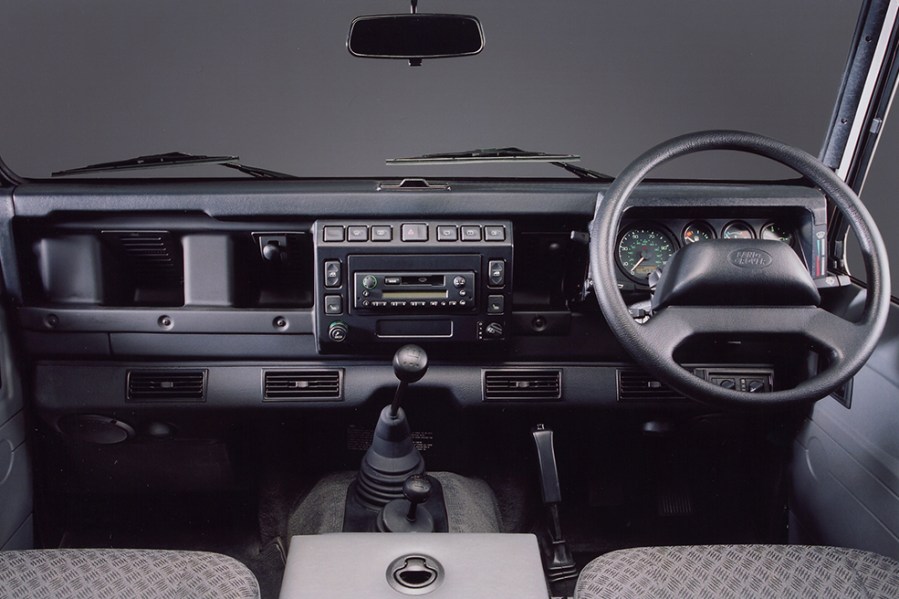Great off-road and loved for its no-nonsense mechanicals, the Land Rover Defender is a stonewall modern classic. Here’s how to buy one
Words: Ian Cushway Images: Land Rover
On sale since 1948, the Land Rover was historically the vehicle of choice for those wanting a back to basics go anywhere workhorse – and the hard as nails Defender from continued that tradition. It was launched as the replacement for the existing 90, 110 and 127 models, which themselves had usurped the old ‘Series’ models to usher in the coil-sprung era from 1983 onwards. You’ll sometimes hear these earlier models referred to as Defenders, but the name didn’t appear until September 1990, when it was adopted to avoid confusion with the new Land Rover Discovery.
The biggest change of this new era was the fitting of the 200Tdi engine from the Discovery – an updated version of the old 2.5-litre turbodiesel with an alloy cylinder head, direct injection, intercooling and other detail changes. The engine was available alongside the V8 and 2.5-litre naturally aspirated diesel and petrol engines, but these were rare.
The station wagon ‘Country’ model was reintroduced in 1992 and the first special edition – the 90SV – arrived with a revised soft top arrangement, metallic paint and the Range Rover’s rear axle with disc brakes, which become standard with the arrival of the 300TDi in 1994. Boasting reduced emissions and increased refinement, it was mated to a new five-speed gearbox (the R380) which replaced the old Leyland unit which first saw service in 1983. In 1998 the 300Tdi was replaced by the Td5, an all-new five-cylinder turbodiesel derived from the Rover L-Series unit, featuring electronic ignition management as opposed to the 300’s all-mechanical set-up, marking the end of an era of unsophisticated bliss for many.
The Defender continued to evolve, a big update in 2007 including an extensive makeover inside and the replacement of the Td5 with a 2.4-litre TDCi turbodiesel from the Ford Transit, mated to a new six-speed gearbox. In 2010, the engine was replaced by a more efficient 2.2 version – bringing the Defender story to its final chapter before production conclude at the start of 2016.
While engines, comfort levels and technology inevitably evolved over time, the Defender’s iconic box-like shape remained largely unchanged. Competition from Japanese manufacturers diminished Land Rover’s dominance of the serious off-road market, but nevertheless the Defender still has a strong and loyal worldwide following, with superb club and specialist backing.
What this means for owners is a huge knowledge base, with virtually every one of the Defender’s weak points identified, as well as a plentiful supply of largely inexpensive spares. Here’s what you need to know.

Bodywork
Despite some panels being made from aluminium, rust will almost certainly be an issue on older Defenders. The worst hit area is likely to be the front bulkhead, which corrodes around the windscreen, fresh-air vents and in the footwells, and is very expensive to put right. Also check the door pillars, the bottom of the doors and steel door frames, plus the crossmembers. Dents in the aluminium panels are common.
Then, of course, there is the steel chassis, which suffers from rot that varies with use and abuse. The rear crossmember is likely to rot first, but rust attacks whole chassis sections, including the rails that support the engine, rear springs and axles, plus the outriggers, which support the body (and, in the worst case, must be cut out and replaced). If you find a sound one, it will certainly pay to get underneath and apply some Waxoyl or similar.
Engine and transmission
The 200Tdi is frugal and reasonably bulletproof – if a little harsh and noisy. The only snag concerns the head gasket which lets go between number four cylinder and one of the pushrod tubes at the back of the engine. You’ll hear it make a chuffing noise. Usually the head can be skimmed, but if not it’s a case of finding a reconditioned replacement.
Other running issues such as misfires may be as a result of faulty injectors, faulty Bosch VE rotary injection pumps, incorrect pump timing, a faulty lift pump or poorly adjusted valve clearances. The 200Tdi’s can also suffer from fuel rail return pipes disintegrating; symptoms include the smell of diesel and visible leaks. However, they’re easily replaced.
Top end oil leaks caused by rubber seals hardening with age are common too, which is why you see so many 200TDi engines coated with oil. The Garrett T25 turbo is robust and long lasting but can also eventually fail, so listen for whistles on signs of blue smoke when accelerating which points to oil leaks.
The 300TDi was more refined, a little faster and smoother but not quite so solid. This engine’s weak point includes coolant leaks and overheating which can lead to warped heads. They can be skimmed, but replacement heads are readily available and they aren’t expensive. Cracks can also occur around the heater plugs and injectors, and worse still between the valves. The manifold gasket can also let go on this engine between the ports, allowing oil to plaster the side of the block. It’s messy but not hard to fix.
The timing belt on both the 200 and 300Tdi should be replaced every 60,000 miles or five years (or half this if used intensively off road) and oil and filter changes carried out every 6000 miles (a 10w40 oil will do). There was an alignment issue with the 300Tdi belt initially and various modification kits were available, but this work should have been done many years ago and there shouldn’t be any problems now.
Despite its electronics, the TD5 is a fantastic unit. People are scared of it, but it’s much faster and more refined than the other turbodiesel units and really isn’t as bad as people make out –specialists know its faults. It’s chain driven, too, so there’s no worries about having to replace a timing belt. The only real maladies include leaky injector seals which will cause poor starting and injector pumps which can fail.
Cylinder heads can also crack inside the cylinder head because of high fuel pressures and thin walls, allowing diesel to drop into the sump. The only other gripe concerns the expensive involved replacing the Dual Mass Flywheel.

The 2007-on Ford engine is very different to what went before and can be long lasting. Some suffer injector issues as well as faulty fuel pressure sensor woes but otherwise, again, it’s a strong unit – albeit one that’s not as DIY friendly as its predecessors.
V8s are rare but suffer more from neglect due to alloy construction. The coolant level needs to be checked, and look out for leaks; overheating can lead to head gasket failure. Another problem is worn camshafts – if the engine feels down on power it could be that the camshaft lobes are worn down.
Transmission-wise, the 200Tdi had the LT77 five-speed gearbox and LT230 transfer box. The 300Tdi had the R380 gearbox, with the LT230 transfer box, as did the later Td5. The R380 had been debugged by the arrival of the Td5, but both the 200 and 300Tdi units can suffer a problem with output shaft not getting enough lubrication and stripping. Various mods were made, but if a gearbox from this era goes, Ashcroft Transmissions sell recon units from around £650.
LT77s can slip out of gear and a worn clutch can make the gearchange obstructive. On the R380-equiiped 300Tdis, be sure to check the third-to-second down-change, as this is a typical weak point. The clutch fork can be a weak point too, as metal wears away and the middle pushes through. The symptom will be that the clutch pedal goes to the floor but won’t come back. Check the service records for a clutch fork.
Early six-speed TDCi gearboxes could lose synchromesh, but many were recalled. On early models, the front prop could touch the sump on full articulation. The sumps were replaced if the vehicles were serviced by the main dealer, so get underneath and check if the sump has a recess to clear the front propshaft.

Suspension, steering and brakes
The Defender’s ride is firm but it can take quite a hammering if used off road so look for broken springs and leaky shocks. A clunk at the rear can be a sign of wear in the rear A-frame balljoint.
As stated earlier, many Defenders go for a long time without proper maintenance. That’s why it’s important to check that there’s grease in the swivel housing, there’s no leaks from the seals and that the balls haven’t become pitted. Also, it’s worth checking there aren’t any leaks from the front diff input shaft seal and that the propshafts are properly greased (via nipples) and that the often leaky transfer boxes are given regular fluid changes.
Brake-wise, you’ll find drums at the rear of the Defender until the arrival of the 300TDi, and these obviously involve a bit more maintenance. That said, there are generally very few problems beyond the occasional rusty cylinder piston – caused by neglect more than anything else – and all the parts are inexpensive.
However, while the 200TDi uses a reliable and trouble-free vane type rotary pump driven off the end of the oil pump drive to power the brake servo, the 300 uses a Wabco plunger type pump driven off the camshaft and the end cover of these can work loose causing it to leak oil. The internals can also wear, leading to a ticking sound and its eventual failure. ABS was an option on the TD5, although it was rare. Again, the unit rarely gives any problems.
Interior, trim and electrics
Trim became steadily more luxurious over the years – and less durable. Heavy use quickly takes its toll on the seats and dashboard. Check for damp carpets and broken window mechanisms and door catches. The TDCi got a full-width dashboard, which combined Discovery and Ford Transit components with switchgear from the Metro and the ignition switch from the Marina. Some claim this is inferior to the old set-up.
Refreshingly, the 200TDi was devoid of complex electronics, as was the 300 – although the last ones did have an ECU. Suffice to say, everything’s very basic and there are few major worries beyond bad earths, botches and poorly wired-in accessories such as foglamps.
Unlike the earlier Defenders, which are sadly some of the easiest to steal vehicles ever produced, the TD5 has an immobiliser and alarm system and sensors for these can sometimes prove problematic – in which case many owners choose to disconnect the alarm.

Land Rover Defender: our verdict
The Defender is iconic and hugely desirable, but all too often, its tough character leads to abuse and lack of regular maintenance – and this involves a lot more than just an oil and filter change. However, when it comes to living with one, there’s little in the way of nasty surprises in store (as long as you inspect the chassis thoroughly for rot) and many of the engines can reach high mileages without problem. Best of all, Defender parts are all freely available – and not that dear – so keeping one in good health shouldn’t be too difficult.
Expect to pay £7000-£8000 for a useable, honest, if slightly worn-looking TDi, but north of £10,000 for something clean and tidy. A Td5 may start at below £10,000, but this could be a false economy – its best to buy a better example, and that could cost around £15,000 or more. You’ll struggle to find a Defender TDCi for under £12,000 and if you do it’ll likely have high mileage. A little patience may secure a good one for around the £16,000 mark, but the best low-mileage examples will likely be well in excess of £20,000, especially for a late example.
Do your homework and avoid buying a money pit. An honest-looking Defender with faded original paintwork might be a better bet than something that’s had a cheap and cheerful blow-over.
Land Rover Defender timeline
1990
Defender name adopted, 200Tdi engine launched with 107bhp, 127 model renamed 130.
1992
Land Rover 90SV special edition released, with 90 cars produced in turquoise with a black canvas Tickford soft top.
1994
111bhp, 300Tdi replaces 200; V8 gets injection.
1995
V8 option dropped.
1998
Defender 50th special edition released featuring 4.0-litre 190bhp V8 and ZF auto transmission. 1071 built, with 385 for UK market.

Land Rover Defender 50th Anniversary
1999
TD5 five-cylinder 2.5-litre turbodiesel launched with 122bhp.
2000
Tomb Raider special edition arrives inspired by the car used in the blockbuster film staring Angelina Jolie
2004
Steel doors replace aluminium items.
2007
2.4-litre Transit turbodiesel with Getrag six-speed ’box fitted, new Discovery dash, steel bonnet added.

A late-model Defender with Ford power and humped bonnet
2011
2.2-litre engine replaces 2.4-litre, with power unchanged, Soft-top returns.
2016
Production ends in January































